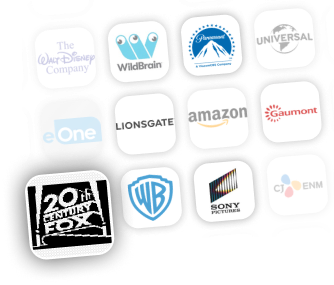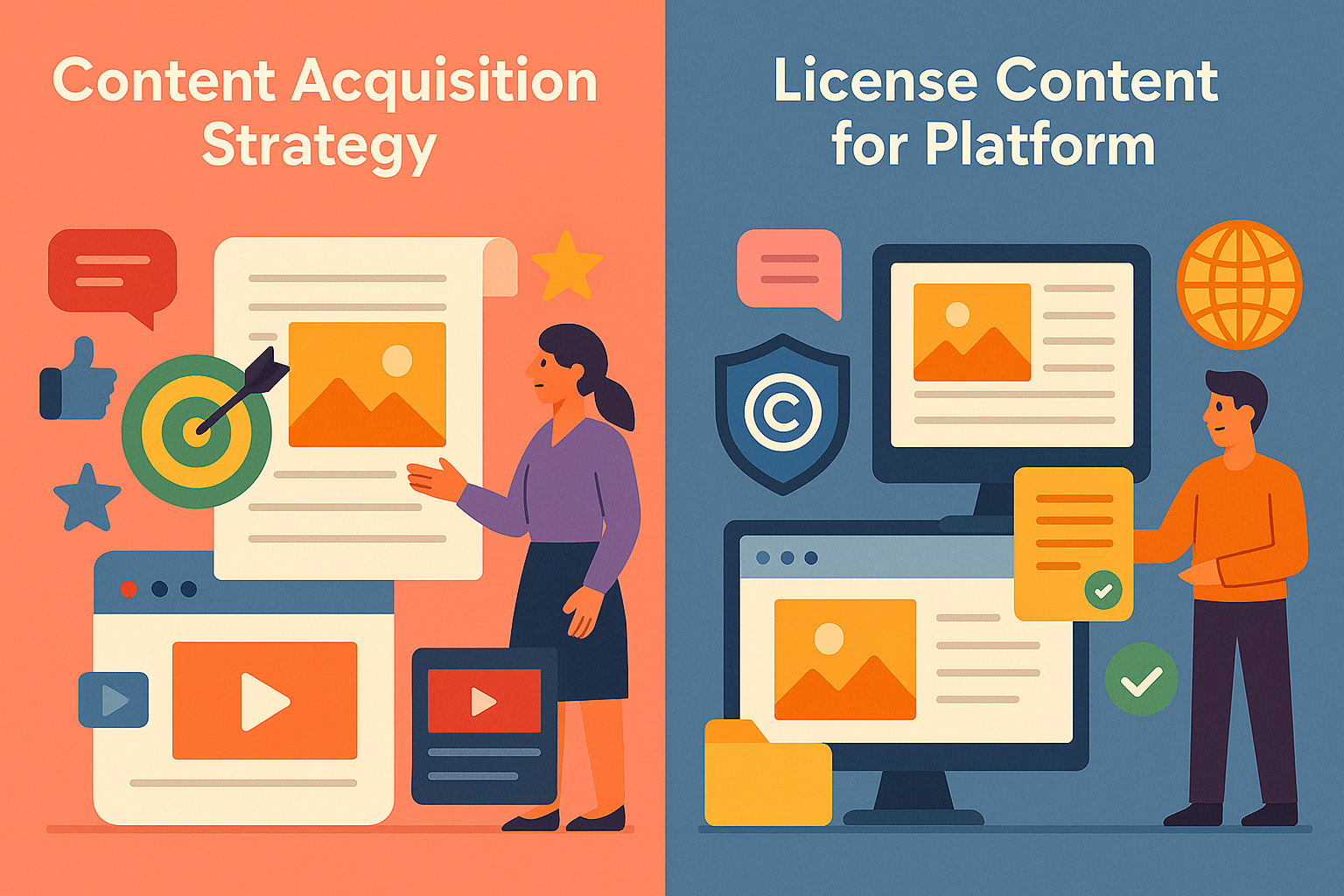Introduction
Hey there, content acquirers, programmers, and platform managers! In today’s crowded media landscape, having a winning content acquisition strategy is more crucial than ever. It’s not just about filling your schedule or library; it’s about finding and licensing the *perfect* content that truly resonates with your specific audience, drives engagement, and sets your platform apart.
Whether you’re looking to license content for platform success on an established TV network or aiming to source content for OTT disruption, the choices you make in acquiring films, TV shows, and other media can make or break your service. This guide will walk you through key strategies for effective VOD content sourcing, provide actionable film acquisition tips, and help you master the art of evaluating content for licensing. Let’s dive in!
Curious how Vitrina can help you? Try it out today!
Trusted by global entertainment leaders to grow business, acquire high-demand content, promote projects and services, and track every Film + TV production worldwide
Table of content
- Introduction
- Key-Takeaways
- What is a Content Acquisition Strategy and Why Do You Need One?
- Step 1: Know Your Audience Inside and Out
- Step 2: Effective VOD Content Sourcing and Discovery Techniques
- Step 3: Evaluating Content for Licensing – Beyond Just Watching
- Step 4: Negotiating the Deal – Key Considerations for Buyers
- Step 5: Leveraging Data in Your TV Programming Strategy
- Future-Proofing Your Content Acquisition Strategy
- Conclusion
- FAQs
Key Takeaways
| Acquisition Aspect | Core Insight | |
|---|---|---|
| Content Acquisition Strategy Defined | A planned approach to identifying, evaluating, and licensing content that aligns with a platform’s audience, brand, and business goals. | |
| Audience Understanding | Deeply knowing your target audience’s preferences, demographics, and viewing habits is the foundation of successful acquisition. | |
| Sourcing Channels | Utilize a mix of content markets, distributors, direct producer outreach, and online marketplaces like Vitrina. | |
| Evaluation Criteria | Assess content based on quality, relevance, performance potential, rights availability, cost, and marketing appeal. | |
| Negotiation & Deal-Making | Securing favorable terms for rights, fees, and exclusivity is key to maximizing ROI. | |
| Data-Driven Decisions | Leveraging viewership data, market trends, and performance analytics to inform acquisition choices. | |
| Further Learning | For a comprehensive overview of licensing, see our Definitive Guide to Content Licensing. | |
Need to Source Content for Your OTT or VOD Service?

What is a Content Acquisition Strategy and Why Do You Need One?
A content acquisition strategy is your roadmap for building a compelling and successful content offering. It’s a deliberate, planned approach that guides how you identify, evaluate, select, and license films, TV series, and other media to meet the specific needs of your platform and audience. Why is it so important? In a world overflowing with content, a clear strategy helps you:
- Focus Your Efforts: Prevents wasting resources on content that doesn’t fit.
- Optimize Your Budget: Ensures you’re investing in content that delivers the best possible return on investment (ROI).
- Attract and Retain Your Target Audience: By consistently offering relevant and engaging programming.
- Differentiate Your Platform: Helps you stand out from competitors by curating a unique content mix.
- Achieve Business Goals: Whether it’s growing subscribers, increasing viewership, or driving ad revenue.
Without a coherent content acquisition strategy, you’re essentially navigating the vast ocean of available content without a compass, making it much harder to license content for platform success. It’s a cornerstone of any effective TV programming strategy or VOD offering.
Key Components of a Strong Strategy:
A robust strategy typically considers:
- Audience Definition: Who are you trying to reach? What are their demographics, psychographics, and viewing preferences?
- Content Pillars/Genres: What types of content will form the core of your offering (e.g., prestige drama, family animation, local documentaries)?
- Content Mix: What’s the desired balance between exclusive vs. non-exclusive, original vs. licensed, library vs. new releases?
- Budget Allocation: How much can you spend on different types of content and rights packages?
- Sourcing Channels: Where will you find potential content (markets, distributors, direct deals, online platforms)?
- Evaluation Metrics: How will you assess the potential success and fit of a piece of content?
- Rights Requirements: What specific rights (territory, window, exclusivity, platforms) do you need?
| Strategic Element | Importance for Buyers | Example |
|---|---|---|
| Audience Understanding | Ensures content resonates and drives engagement. | A kids’ platform focusing on animated content with positive messaging. |
| Budget Optimization | Maximizes ROI and ensures financial sustainability. | Prioritizing library deals for volume and select premium exclusives for impact. |
| Platform Differentiation | Helps stand out in a competitive market. | A niche SVOD service curating hard-to-find arthouse films. |
Step 1: Know Your Audience Inside and Out
The absolute bedrock of any successful content acquisition strategy is a profound understanding of your target audience. Who are they? What do they love to watch? What are their viewing habits? What motivates them to subscribe, tune in, or keep coming back? Answering these questions with as much detail as possible will guide every decision you make, from the types of genres you prioritize to the specific titles you choose to license content for platform viewing. Without this deep audience insight, even the most critically acclaimed content might fail to perform if it doesn’t connect with your viewers.
Methods for Understanding Your Audience:
- Data Analytics: Analyze viewership data from your own platform (if existing) – what content performs well, what are completion rates, what are popular search terms?
- Surveys and Feedback: Directly ask your audience what they want to see through surveys, polls, and feedback forms.
- Social Listening: Monitor social media conversations related to your platform, competitors, and relevant genres to understand sentiment and trends.
- Demographic and Psychographic Research: Understand the age, gender, location, interests, values, and lifestyles of your target viewers.
- Persona Development: Create detailed fictional representations of your ideal audience members to help humanize your data and guide content choices.
This understanding is crucial for effective VOD content sourcing and a successful TV programming strategy.
Translating Audience Insights into Acquisition Goals:
Once you have a clear picture of your audience, you can translate those insights into actionable acquisition goals:
- “Our audience of young adults (18-34) shows high engagement with sci-fi and fantasy series; therefore, we need to prioritize acquiring new and library titles in these genres.”
- “Viewership data indicates a drop-off on weekends; we need to acquire more family-friendly movies for weekend co-viewing.”
- “Surveys show a demand for more local-language content; we need to actively source content for OTT from regional producers.”
This direct link between audience understanding and acquisition targets is a hallmark of a strong content acquisition strategy.
| Audience Insight Tool | What It Tells You | Acquisition Implication |
|---|---|---|
| Platform Viewership Data | Popular genres, content completion rates, peak viewing times. | Acquire more of what works, identify content gaps. |
| Audience Surveys | Direct preferences, unmet needs, desired content types. | Source specific titles or genres requested by viewers. |
| Social Media Monitoring | Buzz around shows/films, competitor sentiment, emerging trends. | Identify trending content, understand competitive landscape. |
Step 2: Effective VOD Content Sourcing and Discovery Techniques
Once you know what kind of content your audience desires, the next step in your content acquisition strategy is actually finding it. The world is awash with films and TV shows, so effective VOD content sourcing and discovery require a multi-pronged approach. This involves actively seeking out opportunities through traditional channels like content markets and distributors, as well as leveraging modern digital platforms that can significantly streamline the search to license content for platform use. Good film acquisition tips often start with knowing where to look.
Traditional Sourcing Channels:
- Content Markets and Festivals: Events like MIPCOM, TIFF, Sundance, Berlinale EFM, and AFM are crucial for discovering new content, meeting with sales agents and producers, and getting a feel for upcoming trends.
- Distributors and Sales Agents: These companies represent catalogs of content from various producers and are a primary source for acquiring rights. Building strong relationships with them is key.
- Direct Outreach to Production Companies/Studios: For specific high-profile titles or when seeking original commissions, direct engagement with producers or studios might be necessary.
Modern Discovery Platforms and Tools:
- Online B2B Marketplaces: Platforms like Vitrina are revolutionizing content discovery. They offer extensive databases of available film and TV content, allowing buyers to search, filter by specific criteria (genre, territory, rights, etc.), view screeners, and connect directly with rights holders. This can dramatically improve the efficiency of evaluating content for licensing.
- Industry Databases and Directories: Resources that list production companies, distributors, and available titles.
- Screening Libraries: Many distributors and markets offer online screening libraries for buyers to review content remotely.
- AI-Powered Recommendation Engines: Some advanced platforms use AI to suggest content based on your platform’s profile, audience data, and past acquisition patterns.
A balanced approach, combining traditional networking with modern digital tools, often yields the best results when trying to source content for OTT and other platforms.
| Sourcing Method | Pros | Cons |
|---|---|---|
| Content Markets/Festivals | Face-to-face networking, early access to new titles, buzz. | Costly (travel/attendance), can be overwhelming. |
| Distributors/Sales Agents | Access to curated catalogs, established relationships. | May involve multiple layers, distributor fees. |
| Online Marketplaces (e.g., Vitrina) | Efficient search, global reach, direct connections, data insights. | Requires active engagement with the platform. |
Refining Your TV Programming Strategy?

Step 3: Evaluating Content for Licensing – Beyond Just Watching
Finding potential content is one thing; thoroughly evaluating content for licensing is another critical step in a successful content acquisition strategy. This goes far beyond simply watching a film or a few episodes of a series and deciding if you “like” it. A strategic evaluation involves assessing multiple factors to determine if the content is a good fit for your platform, if it has strong audience appeal, if the rights are available on favorable terms, and if it makes financial sense. This due diligence is essential before you decide to license content for platform exhibition.
Key Criteria for Content Evaluation:
- Audience Fit and Relevance:
- Does it align with your target audience’s demographics, interests, and preferences?
- Does it fit your platform’s brand identity and programming ethos?
- Quality of Content:
- Storytelling: Engaging plot, well-developed characters, satisfying resolution (or compelling hooks for series).
- Production Values: Cinematography, sound design, editing, visual effects, overall technical quality.
- Performances: Strength and believability of the acting talent.
- Performance Potential & Marketability:
- Is there existing buzz, critical acclaim, or festival recognition?
- Does it feature recognizable talent (actors, directors) that can attract viewers?
- Are there strong marketing angles or unique selling propositions (USPs)?
- How has similar content performed on your platform or competitor platforms (use comps)?
- Rights Availability and Terms:
- Are the specific rights you need (territory, window, exclusivity, platform) available?
- What is the asking price/license fee, and is it within your budget?
- Are the proposed license term and other conditions acceptable? This is a vital part of any film acquisition tips.
- Technical and Delivery Aspects:
- Are high-quality master materials available in the required formats?
- Are there any existing language versions (dubs/subs) or will they need to be created?
Using a Scorecard or Checklist:
Many acquisition teams use a standardized scorecard or checklist to evaluate content consistently across these different criteria. This helps ensure a more objective assessment and allows for easier comparison between multiple potential titles. This systematic approach is a core part of a good TV programming strategy when assessing new shows.
| Evaluation Factor | Question for Buyer | Potential Impact |
|---|---|---|
| Audience Fit | Will our target viewers watch and enjoy this? | High impact on engagement and retention. |
| Content Quality | Is it well-made and compelling? | Reflects on platform brand, influences viewer satisfaction. |
| Marketability | Can we effectively promote this to drive viewership? | Affects discoverability and initial audience draw. |
| Financial Viability | Does the cost align with potential ROI? | Crucial for budget management and profitability. |
Step 4: Negotiating the Deal – Key Considerations for Buyers
Once you’ve evaluated content and decided it’s a strong candidate for your platform, the negotiation phase of the content acquisition strategy begins. This is where you work with the licensor (seller) to agree on the specific terms under which you will license content for platform use. Effective negotiation is crucial for securing the rights you need at a price that makes sense for your business, while also building a positive relationship with the content provider. Good film acquisition tips always emphasize the importance of skillful negotiation.
Key Terms to Negotiate from a Buyer’s Perspective:
- License Fee/Financial Model:
- Aim for a price that aligns with your budget and projected ROI.
- Explore different models: can a high flat fee be mitigated with a revenue share component? Is a Minimum Guarantee appropriate?
- Negotiate payment schedules that work for your cash flow.
- Scope of Rights:
- Be precise about the platforms (SVOD, AVOD, Linear TV, etc.), territories, and languages you require.
- Try to secure rights that give you flexibility (e.g., sufficient catch-up rights for TV, ability to offer downloads on VOD).
- License Term (Duration) and Renewal Options:
- Negotiate a term length that gives you enough time to exploit the content effectively.
- Seek favorable renewal options for successful content, ideally with pre-agreed or capped renewal fees.
- Exclusivity:
- Determine if exclusivity is critical for this particular piece of content. Exclusive rights cost more.
- If seeking exclusivity, define its scope clearly (e.g., exclusive for a specific window on a specific platform in a specific territory).
- Delivery Materials and Timeline: Ensure clear terms on what materials will be provided, their technical specifications, and the delivery schedule.
- Marketing Support: Can the licensor provide marketing assets or even contribute to a marketing fund?
- Warranties and Indemnities: Ensure the licensor provides strong warranties regarding their ownership of rights and indemnifies you against third-party claims (e.g., copyright infringement).
Understanding these helps in evaluating content for licensing from a deal perspective.
Building Leverage and Finding Win-Win Solutions:
Buyers can build leverage by:
- Demonstrating a clear understanding of their audience and how the content fits.
- Highlighting their platform’s reach and marketing capabilities.
- Being prepared to walk away if terms are not acceptable (knowing your BATNA – Best Alternative to a Negotiated Agreement).
- Offering package deals if acquiring multiple titles from the same seller.
Often, the best deals are “win-win,” where both parties feel their key needs are met. This might involve creative trade-offs (e.g., a slightly lower license fee in exchange for a stronger marketing commitment from the buyer).
| Negotiation Area | Buyer’s Ideal Outcome | Potential Compromise |
|---|---|---|
| License Fee | Lowest possible cost. | Performance-based kickers, favorable payment schedule. |
| Exclusivity | Full exclusivity. | Limited window exclusivity, non-exclusive with lower fee. |
| Term Length | Longer term for successful content. | Shorter initial term with favorable renewal options. |
Step 5: Leveraging Data in Your TV Programming Strategy
In today’s media environment, data is king. A truly effective content acquisition strategy, especially for a dynamic TV programming strategy or VOD content sourcing, must be data-driven. Relying solely on gut instinct or past personal preferences is no longer sufficient. By leveraging various forms of data, acquisition executives can make more informed decisions, reduce risk, optimize their content spend, and ultimately deliver a programming slate that deeply resonates with their target audience and achieves business objectives. This analytical approach is key when looking to license content for platform success.
Types of Data to Inform Acquisition Decisions:
- Platform-Specific Viewership Data:
- What content genres, themes, and actors are most popular with your current audience?
- What are the completion rates for different types of content?
- Which titles drive new subscriptions or reduce churn?
- What do search queries on your platform reveal about unmet demand?
- Market-Level Data:
- What are broader industry trends in content consumption?
- How is similar content performing on competitor platforms (if publicly available or through syndicated data)?
- What are the current market rates (comps) for licensing different types of content? Vitrina can be a source for such market intelligence.
- Social Listening and Sentiment Analysis:
- What are people saying about specific shows, films, or genres online?
- What is the buzz around upcoming releases or talent?
- Demographic and Audience Panel Data: Insights into the preferences and behaviors of specific audience segments.
Applying Data to Different Stages of Acquisition:
- Discovery: Data can highlight underserved genres or audience segments, guiding your sourcing efforts.
- Evaluation: Use performance data of comparable titles to help forecast the potential success of a new acquisition.
- Pricing and Negotiation: Market data and comps can provide benchmarks for negotiating fair license fees.
- Programming and Scheduling: Viewership patterns can inform how and when to schedule or promote licensed content.
- Post-Launch Analysis: Continuously track the performance of acquired content to refine your future strategy.
A commitment to evaluating content for licensing through a data lens strengthens every decision.
| Data Type | Use in Acquisition | Benefit |
|---|---|---|
| Internal Viewership Analytics | Identify popular genres, predict performance of similar content. | Reduces risk, improves ROI on licensed content. |
| Market Comps / Pricing Data | Benchmark license fees, inform negotiation strategy. | Ensures fair pricing, optimizes budget. |
| Social Sentiment / Trend Analysis | Gauge audience interest in specific titles or talent. | Helps acquire timely and buzzworthy content. |
Future-Proofing Your Content Acquisition Strategy
The media landscape is in a state of perpetual evolution. Viewer habits shift, new technologies emerge, and competitive dynamics change rapidly. Therefore, a forward-thinking content acquisition strategy isn’t just about what works today; it’s also about anticipating and preparing for the future. To effectively license content for platform longevity and success, buyers need to be agile, adaptable, and attuned to emerging trends. This means looking beyond immediate needs and considering how your content library will remain relevant and valuable in the years to come. This proactive approach is essential for any long-term TV programming strategy or digital platform.
Key Considerations for a Future-Focused Strategy:
- Embracing New Formats and Technologies: Keep an eye on emerging content formats (e.g., interactive content, VR/AR experiences) and how they might fit into your offering. Consider the implications of new delivery technologies (e.g., advancements in streaming quality, immersive audio).
- Understanding Generational Shifts in Viewing: How do younger audiences (e.g., Gen Z, Gen Alpha) consume content differently? What types of stories and platforms resonate with them?
- Diversifying Content Sources: Don’t rely on just a few traditional suppliers. Explore content from emerging international markets, independent creators, and direct-to-consumer models. Platforms like Vitrina can help in discovering diverse global content.
- Flexible Rights Management: Negotiate for rights packages that offer flexibility as platform strategies evolve (e.g., ability to exploit content across different VOD models if your business shifts).
- Investing in Evergreen Content: Balance new, buzzworthy titles with “evergreen” library content that retains its appeal over time and can be re-licensed or re-promoted.
- Monitoring Regulatory Changes: Stay aware of evolving regulations around content classification, data privacy, and digital rights in your key markets.
Proactive VOD content sourcing involves thinking about tomorrow’s audience today.
| Future Trend | Potential Impact on Acquisition | Strategic Response for Buyers |
|---|---|---|
| AI in Content Creation/Curation | New types of content, AI-assisted discovery. | Explore licensing AI-influenced content, use AI tools for sourcing. |
| Interactive & Immersive Media | Demand for non-linear, engaging experiences. | Experiment with licensing interactive formats if brand-appropriate. |
| Globalization of Content Tastes | Increased appetite for diverse international content. | Actively source and license content from a wider range of territories. |
Conclusion
Developing and executing a robust content acquisition strategy is fundamental to the success of any media platform, whether it’s a traditional broadcaster, a cutting-edge OTT service, or a specialized VOD provider. By deeply understanding your audience, effectively sourcing and evaluating content, skillfully negotiating deals, and leveraging data, you can build a content library that not only attracts and retains viewers but also achieves your core business objectives. Remember that the journey to license content for platform success is an ongoing process of refinement and adaptation in response to a constantly changing media world.
As you implement your TV programming strategy or refine your film acquisition tips, always keep the end-user – your audience – at the forefront of your decisions. Platforms like Vitrina are designed to support this strategic approach by providing tools and intelligence to make smarter, faster, and more effective content acquisition choices. For a broader view of the entire licensing landscape, refer to our Definitive Guide to Content Licensing.
Ready to supercharge your content acquisition? Explore Vitrina to discover a world of content and connect with global rights holders today!
Frequently Asked Questions
Ideally, a content acquisition strategy should have both short-term (6-12 months) and long-term (1-3 years, or even longer for some foundational library deals) components. The lead times for acquiring and preparing content, especially for exclusive or first-window rights, can be significant.
“Originals” typically refer to content that a platform commissions or produces itself (or has exclusive “first-window” global rights to, branding it as their own). “Licensed content” is acquired from third-party rights holders for a specific period and territory. Many platforms use a mix of both in their TV programming strategy.
While online discovery platforms are increasingly important for VOD content sourcing, major content markets still play a vital role for face-to-face networking, discovering brand new projects (especially pre-sales), gauging industry buzz, and closing significant deals. Many buyers use a hybrid approach.
Common mistakes include: not thoroughly understanding your target audience, overpaying for content without clear ROI potential, acquiring rights that don’t align with your platform’s strategy (e.g., wrong territory, window, or exclusivity), insufficient due diligence on rights ownership (chain of title), and not having a clear plan for marketing and promoting the acquired content.





























